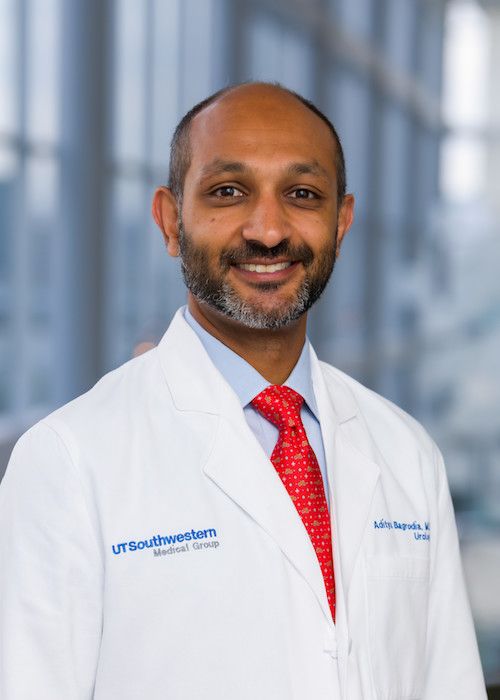Article
Study shows potential to overcome impact of sociodemographic factors on testicular cancer outcomes
Author(s):
A standardized, multidisciplinary approach led to similar outcomes based on disease characteristics, not sociodemographic factors.
Aditya Bagrodia, MD

Standardized treatment of patients with testicular cancer can overcome sociodemographic factors linked to worse clinical outcomes, according to an article published in Cancer.1,2
The study showed that patient outcomes across a broad sociodemographic spectrum were similar when the patients received high-quality multidisciplinary care from the same group of physicians at 2 different hospitals.
“It was really encouraging to verify that these men are being treated based on their disease characteristics, not on who they are or what hospital they’re being treated at,” study leader Aditya Bagrodia, MD, an assistant professor of urology at UT Southwestern (UTSW), said in a press release. “It doesn’t—and shouldn’t—matter if you’re Black, white, or Hispanic, rich or poor, insured or uninsured.”
Bagrodia and colleagues at UT Southwestern reviewed patient records for outcomes from 201 patients who received primary treatment for testicular germ cell tumors (GCTs) between 2006 and 2018 at either a public safety net hospital (Parkland Memorial Hospital; n = 106) or an academic tertiary care center (UT Southwestern Medical Center; n = 95).
Patient cases at these 2 locations are handled by Bagrodia and his multidisciplinary UTSW team, which includes urologists, oncologists, radiologists, radiation oncologists, and pathologists. Multidisciplinary team meetings are held to review patient cases from both locations. Further, the same group of clinicians rotates between the 2 locations to perform surgery and provide other necessary care.
The patient characteristics/demographics were different between the populations treated at each location. Patients treated at the Parkland public safety net hospital were more likely to be Hispanic (79% vs 11%) and uninsured (80% vs 12%). They were also younger (average age of 29 vs 33); more likely to have metastatic disease (42% vs 26%); more likely to present at the emergency department compared with at a primary care physician (76% vs 8%); and reported experiencing disease symptoms for far longer before deciding to come to the hospital (average of 65 vs 31 days).
“These young men [treated at the public safety net hospital] often get embarrassed about their symptoms, and then they delay coming in to be seen for other reasons—they can’t miss work, they don’t have insurance, they’re worried about being deported,” said Bagrodia.
Bagrodia et al found that despite the potential adverse impact of the sociodemographic differences between the populations, the standardized approached led to comparable treatment for patients at the 2 facilities. Orchiectomies were administered at an average of 1 day and 4 days after diagnosis at Parkland and UTSW, respectively. Following the initial orchiectomy, any additional treatment was equally likely to be received by patients with similar disease characteristics, regardless of their treatment location.
At 4.7% versus 6.3%, there was not a statistically significant difference in the recurrence rate of patients treated at Parkland or UTSW, respectively. During the treatment time period, 4 patients at Parkland died compared to none at UTSW; however, the difference was attributable to the patients’ cancer stage at diagnosis, not the treatment location.
Multivariable analysis showed an embryonal carcinoma component (odds ratio [OR], 0.36; P= .02) and absence of lymphovascular invasion (OR, 0.30; P= .008) were linked to lower use of adjuvant therapy, while treatment location was not (OR, 0.67; P= .55). There was also no difference in the rate of postchemotherapy retroperitoneal lymph node dissection used among patients with stage II/III nonseminomatous GCTs, regardless of treatment locations: 52% at Parkland versus 64% at UTSW (P = .53).
“Whether it’s for cancer, refractory diabetes, or heart failure, I think having mechanisms to make sure you have the right expertise, and committed clinicians, makes a big difference to patients,” said Bagrodia.
References
1. UT Southwestern levels the playing field for testicular cancer patients. Published online August 9, 2020. https://bit.ly/2XM79Zw. Accessed August 10, 2020.
2. Chertack N, Ghandour RA, Singla N, et al. Overcoming sociodemographic factors in the care of patients with testicular cancer at a safety net hospital [published online August 10, 2020]. Accessed August 10, 2020. doi: 10.1002/cncr.33076

















